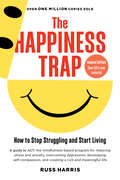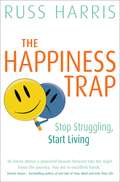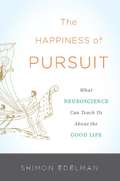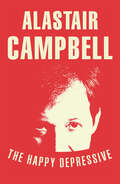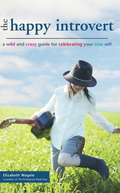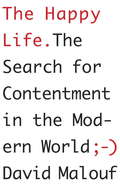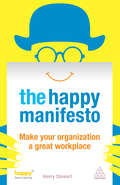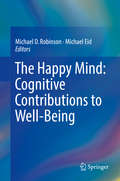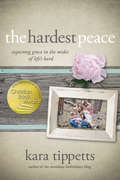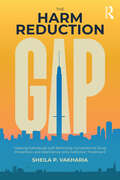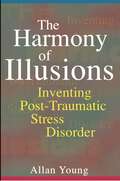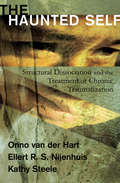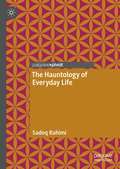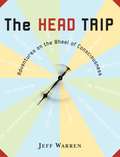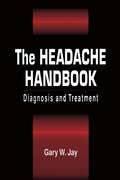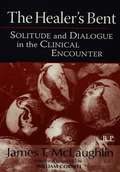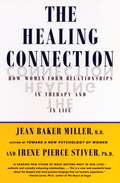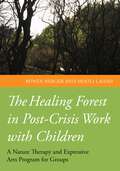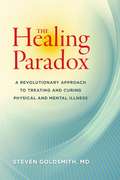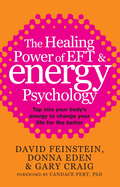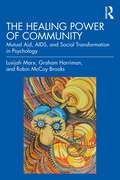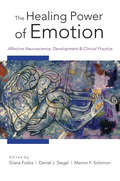- Table View
- List View
The Happiness Trap: A Guide to ACT
by Steven Hayes Russ HarrisAre you, like milllions of Americans, caught in the happiness trap? Russ Harris explains that the way most of us go about trying to find happiness ends up making us miserable, driving the epidemics of stress, anxiety, and depression. This empowering book presents the insights and techniques of ACT (Acceptance and Commitment Therapy) a revolutionary new psychotherapy based on cutting-edge research in behavioral psychology. By clarifying your values and developing mindfulness (a technique for living fully in the present moment), ACT helps you escape the happiness trap and find true satisfaction in life. The techniques presented in The Happiness Trap will help readers to: * Reduce stress and worry * Handle painful feelings and thoughts more effectively * Break self-defeating habits * Overcome insecurity and self-doubt * Create a rich, full, and meaningful life
The Happiness Trap: How to Stop Struggling and Start Living (Second Edition)
by Russ HarrisBuild a more satisfying and meaningful life with this best-selling guide to freeing yourself from depression, anxiety, and insecurity through Acceptance and Commitment TherapyAre you, like millions of Americans, caught in the happiness trap? Russ Harris explains that the way most of us go about trying to find happiness ends up making us miserable, driving the epidemics of stress, anxiety, and depression. This empowering book presents the insights and techniques of ACT (Acceptance and Commitment Therapy) a revolutionary new psychotherapy based on cutting-edge research in behavioral psychology. By clarifying your values and developing mindfulness (a technique for living fully in the present moment), ACT helps you escape the happiness trap and find true satisfaction in life.The techniques presented in The Happiness Trap will help readers to: • Reduce stress and worry • Handle painful feelings and thoughts more effectively • Break self-defeating habits • Overcome insecurity and self-doubt • Create a rich, full, and meaningful life&“ . . . a powerful beacon showing us another way forward.&” —Steven Hayes, PhD, author of Get Out of Your Mind and Into Your Life
The Happiness Trap: Stop Struggling, Start Living
by Russ HarrisTHE MILLION COPY BESTSELLERDo you ever feel worried, miserable or unfulfilled - yet put on a happy face and pretend everything's fine? You are not alone. Stress, anxiety, depression and low self-esteem are all around. Research suggests that many of us get caught in a psychological trap, a vicious circle in which the more we strive for happiness, the more it eludes us.Fortunately, there is a way to escape from the 'Happiness Trap', a ground-breaking new approach based on mindfulness skills. Using the six principles of Acceptance and Commitment Therapy (ACT), Russ Harris can help you to:· Reduce stress and worry· Rise above fear, doubt and insecurity· Handle painful thoughts and feelings more effectively· Break self-defeating habits· Improve performance and find fulfilment in your work· Build more satisfying relationships· Create a richer and more meaningful life
The Happiness of Pursuit: What Neuroscience Can Teach Us About the Good Life
by Shimon EdelmanWhen fishing for happiness, catch and release. Remember these seven words-they are the keys to being happy. So says Shimon Edelman, an expert on psychology and the mind. In The Happiness of Pursuit, Edelman offers a fundamental understanding of pleasure and joy via the brain. Using the concept of the mind as a computing device, he unpacks how the human brain is highly active, involved in patterned networks, and constantly learning from experience. As our brains predict the future through pursuit of experience, we are rewarded both in real time and in the long run. Essentially, as Edelman discovers, it’s the journey, rather than the destination, that matters. The idea that cognition is computation-the brain is a machine-is nothing new of course. But, as Edelman argues, the mind is actually a bundle of ongoing computations, essentially, the brain being one of many possible substrates that can support them. Edelman makes the case for these claims by constructing a conceptual toolbox that offers readers a glimpse of the computations underlying the mind’s faculties: perception, motivation and emotions, action, memory, thinking, social cognition, learning and language. It is this collection of tools that enables us to discover how and why happiness happens. An informative, accessible, and witty tour of the mind, The Happiness of Pursuit offers insights to a thorough understanding of what minds are, how they relate to each other and to the world, and how we can make the best of it all.
The Happy Depressive: In Pursuit of Personal and Political Happiness
by Alastair CampbellAre you happy? Does it matter?Increasingly, governments seem to think so. As the UK government conducts its first happiness survey, Alastair Campbell looks at happiness as a political as well as a personal issue; what it should mean to us, what it means to him. Taking in economic and political theories, he questions how happiness can survive in a grossly negative media culture, and how it could inform social policy. But happiness is also deeply personal. Campbell, who suffers from depression, looks in the mirror and finds a bittersweet reflection, a life divided between the bad and not-so-bad days, where the highest achievements in his professional life could leave him numb, and he can somehow look back on a catastrophic breakdown twenty-five years ago as the best thing that happened to him. He writes too of what he has learned from the recent death of his best friend, further informing his view that the pursuit of happiness is a long game.Originally published as part of the Brain Shots series, the pre-eminent source for high-quality, short-form digital non-fiction.
The Happy Introvert: A Wild and Crazy Guide to Celebrating Your True Self
by Elizabeth WageleBE YOURSELFBE INTROVERTEDBE HAPPYAll your life you've heard the myths . . . Introverts are depressed and lonely. Introverts wish they were more outgoing. Introverts lack self-confidence.These stereotypes about introverts have been propagated by the people who do all the loud talking-the extroverts. To counter these (and many more) common misconceptions, author Elizabeth Wagele, a self-proclaimed introvert, offers a book that delivers the truth: The Happy Introvert.This compassionate guide explores the rich inner world you as an introvert enjoy. The insightful advice-presented in a fun format of provocative quizzes wacky cartoons and inspiring quotes-will help you better appreciate your uniqueness.With The Happy Introvert, you'll learn to navigate the extroverted world without compromising your creative, independent self.
The Happy Life
by David MaloufBy Australia's greatest contemporary author, an elegant, succinct meditation on what makes for a happy life. ;-)"Happiness surely is among the simplest of human emotions and the most spontaneous," says David Malouf. But what exactly are we looking for when we chase happiness? At this particular moment in history, privileged, industrialized nations have lessened much of what makes us unhappy: widespread poverty, illness, famine. Yet we are still unfulfilled, turning increasingly to yoga, church, Match.com, drugs, clinical therapy and retail therapy. What is at the root of our collective stress, and how can we find our way to contentment? Drawing on mythology, philosophy, art and literature, Malouf traces our conception of happiness throughout history, distilling centuries of thought into a lucid narrative. He discusses the creation myths of ancient Greece and the philosophical schools of Athens, analyzes Thomas Jefferson's revolutionary declaration that "the pursuit of happiness" is a right, explores the celebration of sensual delight in Rembrandt and Rubens and offers a perceptive take on a modern society growing larger and more impersonal. With wisdom and insight, Malouf investigates that simplest, most spontaneous of feelings and urges us to do the same.
The Happy Manifesto
by Henry StewartImagine a workplace where people are energized and motivated by being in control of the work they do. Imagine they are trusted and given freedom, within clear guidelines, to decide how to achieve their results. Imagine they are able to get the life balance they want. Imagine they are valued according to the work they do, rather than the number of hours they spend at their desk.Wouldn't you want to work there? Wouldn't it also be the place that would enable you to work at your best and most productive? The Happy Manifesto is a guide to anyone wanting to improve their workplace. Learn how you too could change your work environment for the better.
The Happy Mind: Cognitive Contributions to Well-Being
by Michael D. Robinson Michael EidThis edited volume focuses on different views of happiness and well-being, considering constructs like meaning and spirituality in addition to the more standard constructs of positive emotion and life satisfaction. A premise of the volume is that being happy consists of more than having the right things happen to us; it also depends on how we interpret those events as well as what we are trying to achieve. Such considerations suggest that cognitive-emotional factors should play a fairly pronounced role in how happy we are. The present volume pursues these themes in the context of 25 chapters organized into 5 sections. The first section centers on cognitive variables such as attention and executive function, in addition to mindfulness. The second section considers important sources of positive cognition such as savoring and optimism and the third section focuses on self-regulatory contributions to well-being. Finally, social processes are covered in a fourth section and meaning-related processes are covered in the fifth. What results is a rich and diverse volume centering on the ways in which our minds can help or hinder our aspirations for happiness.
The Hardest Peace
by Kara TippettsKara Tippetts knows the ordinary days of mothering four kids, the joy of watching her children grow ... and the devestating reality of stage-four cancer. In The Hardest Peace, Kara doesn't offer answers for when living is hard, but she asks us to join her in moving away from fear and control and toward peace and grace. Most of all, she draws us back to the God who is with us, in the mundane and the suffering, and who shapes even our pain into beauty.
The Harm Reduction Gap: Helping Individuals Left Behind by Conventional Drug Prevention and Abstinence-only Addiction Treatment
by Sheila P. VakhariaThis long-awaited book teaches how harm reduction can be a safety net for people with substance use disorders that our current addiction treatment rejects, abandons, and leaves behind. Harm reduction is an approach to helping people who engage in high-risk activities to develop the skills and strategies to keep them and their communities safe. This can include the provision of sterile equipment, low-threshold and low-barrier care, and the acceptance of non-abstinence goals in treatment. In this novel guide, Dr. Vakharia discusses the shortcomings of the dominant “Just Say No” drug prevention messages and abstinence-only treatment approaches, introduces harm reduction strategies and technologies borne from people who use drugs themselves, and suggests various policy options available as alternatives to the current policies that criminalize drugs, drug-using equipment, and the settings in which people use drugs. The final chapter calls on the reader to destigmatize drug use and support efforts to reform our drug policies. By highlighting the large gap in our current approach to substance use – the harm reduction gap – this book is the first step for those interested in learning more about the limitations of our current approach to drug use and how to support local efforts to ensure people who use drugs and their communities can stay safe.
The Harmony of Illusions: Inventing Post-Traumatic Stress Disorder
by Allan YoungAs far back as we know, there have been individuals incapacitated by memories that have filled them with sadness and remorse, fright and horror, or a sense of irreparable loss. Only recently, however, have people tormented with such recollections been diagnosed as suffering from "post-traumatic stress disorder." Here Allan Young traces this malady, particularly as it is suffered by Vietnam veterans, to its beginnings in the emergence of ideas about the unconscious mind and to earlier manifestations of traumatic memory like shell shock or traumatic hysteria. In Young's view, PTSD is not a timeless or universal phenomenon newly discovered. Rather, it is a "harmony of illusions," a cultural product gradually put together by the practices, technologies, and narratives with which it is diagnosed, studied, and treated and by the various interests, institutions, and moral arguments mobilizing these efforts. This book is part history and part ethnography, and it includes a detailed account of everyday life in the treatment of Vietnam veterans with PTSD. To illustrate his points, Young presents a number of fascinating transcripts of the group therapy and diagnostic sessions that he observed firsthand over a period of two years. Through his comments and the transcripts themselves, the reader becomes familiar with the individual hospital personnel and clients and their struggle to make sense of life after a tragic war. One observes that everyone on the unit is heavily invested in the PTSD diagnosis: boundaries between therapist and patient are as unclear as were the distinctions between victim and victimizer in the jungles of Southeast Asia.
The Harvard Lectures
by Anna FreudThis remarkable series of introductory lectures on psychoanalysis is, in fact, a lucid, elegant and profound overview of classic psychoanalytic theory, in which the main aspects of psychoanalytic psychology are spelt out. The simple and clear language characteristic of the author's lecturing, the precision of her concepts and their mutual relationships, and their liveliness of this comprehensive synthesis make for a thought provoking, exciting reading experience.
The Haunted Self: Structural Dissociation and the Treatment of Chronic Traumatization (Norton Series on Interpersonal Neurobiology) (Norton Series on Interpersonal Neurobiology #0)
by Onno Van Hart Kathy Steele Ellert R. NijenhuisLife is an ongoing struggle for patients who have been chronically traumatized. They typically have a wide array of symptoms, often classified under different combinations of comorbidity, which can make assessment and treatment complicated and confusing for the therapist. Many patients have substantial problems with daily living and relationships, including serious intrapsychic conflicts and maladaptive coping strategies. Their suffering essentially relates to a terrifying and painful past that haunts them. Even when survivors attempt to hide their distress beneath a facade of normality--a common strategy--therapists often feel besieged by their many symptoms and serious pain. Small wonder that many survivors of chronic traumatization have seen several therapists with little if any gains, and that quite a few have been labeled as untreatable or resistant. In this book, three leading researchers and clinicians share what they have learned from treating and studying chronically traumatized individuals across more than 65 years of collective experience. Based on the theory of structural dissociation of the personality in combination with a Janetian psychology of action, the authors have developed a model of phase-oriented treatment that focuses on the identification and treatment of structural dissociation and related maladaptive mental and behavioral actions. The foundation of this approach is to support patients in learning more effective mental and behavioral actions that will enable them to become more adaptive in life and to resolve their structural dissociation. This principle implies an overall therapeutic goal of raising the integrative capacity, in order to cope with the demands of daily life and deal with the haunting remnants of the past, with the "unfinished business" of traumatic memories. Of interest to clinicians, students of clinical psychology and psychiatry, as well as to researchers, all those interested in adult survivors of chronic child abuse and neglect will find helpful insights and tools that may make the treatment more effective and efficient, and more tolerable for the suffering patient.
The Hauntology of Everyday Life
by Sadeq RahimiThis volume develops a comprehensive framework for applying the theory of hauntology to everyday life from ethnographic and clinical points of view. The central argument of the book is that all human experience is fundamentally haunted, and that a shift from ontological theory of subjective experience to a hauntological one is necessary and has urgent implications. Building on the notion of hauntology outlined by Derrida, the discussions are developed within the frameworks of psychoanalytic theory, specifically Jacques Lacan’s object relational theory of ego development and his structural reading of Freud’s theory of the psychic apparatus and its dynamics; along with the Hegelian ontology of the negative and its later modifications by 20th century philosophers such as Heidegger and Derrida; and the semiotics of difference introduced by Saussure and worked by Jakobson and others. This book argues and demonstrates the immediate relevance of hauntological analysis in everyday life by providing a microanalysis of the roles played by power, meaning and desire; and by using vignettes and data from ethnographic research and clinical settings, as well as references to literature, movies and other cultural products.
The Head Trip: Adventures on the Wheel of Consciousness
by Jeff WarrenA world at once familiar and unimaginably strange exists all around us, and within us -- it is the vast realm of consciousness. In The Head Trip, science journalist Jeff Warren explores twelve distinct, natural states of consciousness available to us in a twenty-four-hour day, each state offering its own kind of knowledge and insight -- its own adventure.
The Headache Handbook: Diagnosis and Treatment
by Gary W. JayThe Headache Handbook: Diagnosis and Treatment helps both generalist and specialist clinicians, including family practitioners, chiropractors, and neurologists, to understand headache, possibly the most ubiquitous symptom in medicine. This comprehensive work covers the myriad of differences among headache patients and the need for accurate fact gathering and physical and neurological examinations. Topics include anatomy and physiology of headache; evaluation and treatment of various headache types; interventional procedures; and manual medicine consultations.
The Healer's Bent: Solitude and Dialogue in the Clinical Encounter (Relational Perspectives Book Series)
by James McLaughlinOver the course of a 50-year career, James T. McLaughlin has sought to open the playing field of psychoanalytic exploration by treating unconscious processes as the very material from which we fashion meaningful lives. His unique, iconoclastic perspective, which challenged the conventions of his time and professional milieu, not only engages the creative tension between the stance of the analyst and the stance of the healer, but also contains striking intimations of contemporary relational and interpersonal models of psychoanalytic treatment. The Healer's Bent, which thematically integrates published and unpublished papers and contains three chapters of heretofore unpublished autobiographical reflection, bridges analytic practice and other psychotherapeutic modalities. It will make McLaughlin's distinct approach to clinical theory and practice widely available to a broad and receptive readership.
The Healing Connection
by Jean Baker MillerIn The Healing Connection, Jean Baker Miller, M.D., author of the best-selling Toward a New Psychology of Women, and Irene Stiver, Ph.D., argue that relationships are the integral source of psychological health. In so doing they offer a new understanding of human development that points a way to change in all of our institutions-work, community, school, and family-and is sure to transform lives.
The Healing Effect of the Forest in Integrative Therapy: With Numerous Exercise Examples for Practice (essentials)
by Astrid Polz-WatzenigThe healing effects of the forest in integrative therapy are the focus of this book. Special emphasis is placed on teaching active forest life exercises that can be used in therapeutic practice in individual and group settings. In addition, the application as a prescription in the context of therapeutic interventions is demonstrated and the importance of increasing the inclusion of forest life in the case history is clarified. The attitude of complex mindfulness and lived integrative ecopsychosomatics open up possibilities of a care for the world in a time of alienation from nature with a simultaneous longing for nature; the commitment to the preservation of nature strengthens an experience of solidarity and is at the same time effective self-care.
The Healing Forest in Post-Crisis Work with Children: A Nature Therapy and Expressive Arts Program for Groups
by Mooli Lahad Ronen Berger Igor KovyarNature Therapy is an innovative approach for working with children who have experienced stress or trauma. For the first time in the English language, this book presents the theory behind the approach along with detailed guidelines for introducing it to the classroom and other group settings The flexible 12-session programme pairs nature-based activities with storytelling and other expressive arts approaches. It is designed to strengthen coping and resilience in children who have been through common causes of stress such as the divorce of parents, moving home, the illness of a loved one or bullying. It can also be used in the aftermath of large-scale crises such as war, terrorism and natural disasters to prevent and treat post-traumatic stress disorder. An evocative colour storybook, 'The Guardians of the Forest', is also included for use within the programme. The original, evidence-based approach described in this book will be of interest to all those working therapeutically or creatively with children who have experienced stress or trauma, including teachers, arts therapists, psychologists and counsellors.
The Healing Paradox: A Revolutionary Approach to Treating and Curing Physical and Mental Illness
by Steven GoldsmithWhy does Western medicine fail to cure chronic physical and mental illness? Why do so many treatments and drugs work only for a limited time before eventually losing effectiveness or producing harmful side effects? Dr. Steven Goldsmith's answer is at once counterintuitive and commonsensical: the root of the problem is our combative approach. Instead of resisting and fighting our ailments, we should cooperate with and even embrace them. We should look for and apply treatments that are integrated with the causes of illness, not regard illness as an enemy to conquer. This "hair of the dog" principle is already widely evident in practice. Take, for example, vaccines and inoculations, which are small doses of the microbes that cause the diseases being prevented; the use of the stimulant Ritalin to calm and ground people with Attention Deficit Hyperactivity Disorder; and radiation, which is both a well-known cause of cancer and a well-known method of treating it. These are just a few of Goldsmith's many examples, which he relays in clear, evocative, and thought-provoking language. Perhaps most compelling of all, he explores reasons why this clearly effective principle is ignored by Western medicine. Drawing on fascinating case studies and personal experiences from his forty-year career as a medical doctor and psychiatrist--as well as abundant clinical, experimental, and public health data that support his seemingly paradoxical assertion--Dr. Goldsmith presents an exciting, revolutionary approach that will change the way you think about medicine and psychotherapy.¶From the Trade Paperback edition.fective principle is ignored by Western medicine. Drawing on fascinating case studies and personal experiences from his forty-year career as a medical doctor and psychiatrist--as well as abundant clinical, experimental, and public-health data that support his radical assertion--Dr. Goldsmith presents an exciting, revolutionary approach that will change the way you think about treating mental and physical illness.From the Trade Paperback edition.
The Healing Power Of EFT and Energy Psychology: Tap into your body's energy to change your life for the better
by Donna Eden David Feinstein Gary CraigYour body is comprised of energy pathways and energy centres that are in constant motion, interconnecting with your cells, organs, immune system, mood and thoughts. THE HEALING POWER OF EFT AND ENERGY PSYCHOLOGY incorporates the concepts of Emotional Freedom Techniques (EFT) to show you how to shift these energies, so you can influence your physical health, your emotional patterns, and your state of mind. With this strategy, stubborn phobias often fade in minutes, the lifelong effects of an early trauma can frequently be reduced or completely eliminated, uncontrollable anger can rapidly become manageable and even elusive physical problems may respond where other treatments have failed. Here are simple step-by-step instructions to help you: change unwanted habits and behaviours; enhance your ability to love, succeed and enjoy life; overcome fear, guilt, shame, jealousy or anger. This clearly illustrated and easy to follow energy approach will help bring about significant change in your life.
The Healing Power of Community: Mutual Aid, AIDS, and Social Transformation in Psychology
by Robin McCoy Brooks Lusijah Marx Graham HarrimanThe Healing Power of Community offers a diverse cross section of interdisciplinary and depth-psychological perspectives in support of using mutual aid approaches in all levels of group and community practice as a remedy for individualism and social and political divisions, centering social justice.Written by three distinct voices who collaborated at the height of the AIDS crisis, the book begins with an autoethnographic study of Project Quest, an HIV/AIDS clinic established in 1989, before looking at how the lessons learnt from this clinic can be applied to our current global mental health climate. Filled with clinical and theoretical applications, chapters include content on what mutual aid communities are, rethinking professionalism and boundaries in a crisis, healing collective trauma, group psychotherapy, psychodrama, depth psychology, and how mental health professionals can support radical change of key structures in nonprofit clinics, public administration, private practice, and research. Arguing for their approach of radicalizing mental health and community-based practice today, the book examines how this can be achieved by moving beyond individual-level approaches, creating new frameworks to meet the mental health needs of our era in creative ways.This book is designed to engage clinical social workers and mental health care clinicians working in community-based mental health, as well as those involved in community psychology, collective trauma and grief, HIV/AIDS advocacy, policy making, and political advocacy.
The Healing Power of Emotion: Affective Neuroscience, Development & Clinical Practice (Norton Series on Interpersonal Neurobiology)
by Daniel J. Siegel Marion Solomon Diana FoshaDrawing on cutting-edge neuroscience to better understand emotion. We are hardwired to connect with one another, and we connect through our emotions. Our brains, bodies, and minds are inseparable from the emotions that animate them. Normal human development relies on the cultivation of relationships with others to form and nurture the self-regulatory circuits that enable emotion to enrich, rather than enslave, our lives. And just as emotionally traumatic events can tear apart the fabric of family and psyche, the emotions can become powerful catalysts for the transformations that are at the heart of the healing process. In this book, the latest addition to the Norton Series on Interpersonal Neurobiology, leading neuroscientists, developmental psychologists, therapy researchers, and clinicians illuminate how to regulate emotion in a healthy way. A variety of emotions, both positive and negative, are examined in detail, drawing on both research and clinical observations. The role of emotion in bodily regulation, dyadic connection, marital communication, play, well-being, health, creativity, and social engagement is explored. The Healing Power of Emotion offers fresh, exciting, original, and groundbreaking work from the leading figures studying and working with emotion today. Contributors include: Jaak Panksepp, Stephen W. Porges, Colwyn Trevarthen, Ed Tronick, Allan N. Schore, Daniel J. Siegel, Diana Fosha, Pat Ogden, Marion F. Solomon, Susan Johnson, and Dan Hughes.
